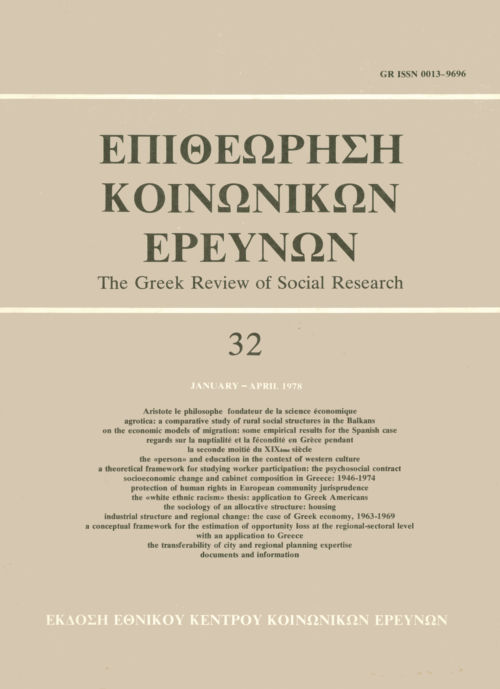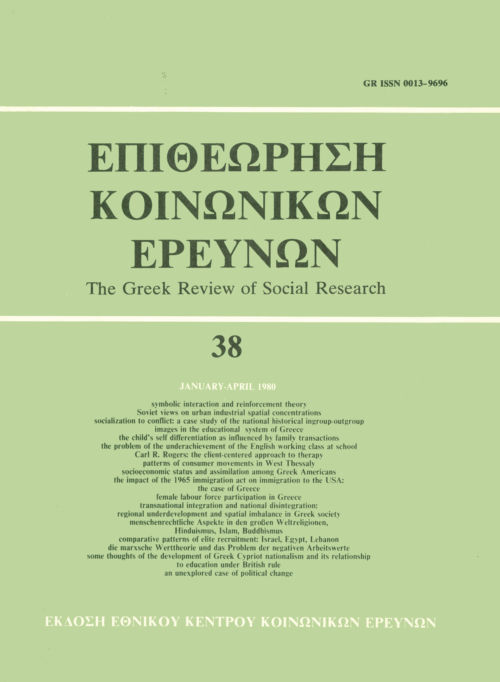The "white" ethnic racism" thesis: Application to Greek Americans
Abstract
The present report used data collected predomin
antly from second-generation Greek-Americans to
test the white-ethnic racism thesis. The thesis states
that the descendants of «new immigrant» groups
— especially their working class descendants, are
prejudiced toward minorities, particularly toward
blacks. Two approaches were used to evaluate the
thesis.
In the first approach, a number of ethnic indicators
(e.g. demographic, attitudinal, cognitive, and
behavioral) were compared to the respondent’s level
of tolerance toward Jews and blacks. Some associa
tion between «Greekness» and prejudice was noted.
There was no uniformity, however, across indicators,
with some ethnic indicators (e.g. low assimilation
orientation) being correlatedwith intolerance toward
the Jews and other ethnic indicators (e.g. number of
years in Greek school) being associated with rejec
tion of stereotypes about blacks. In addition, there
were few strong correlations between the various
ethnic indicators and prejudice. Finally, some of the
associations between ethnicity and prejudice were
not robust when more.traditional correlates of prej
udice. such as educational level and authori
tarianism, were controlled. Thus, the ethnic factors had
a limited predictive capacity. This, however, does
not mean that the «universal» correlates of prej
udice, such as education and authoritarianism, can
not interact with cultural tradition to produce a high
level of racism.
The white-ethnic racism thesis was also tested
under standardized conditions of economic status.
Two indices of economic status, reported annual in
come and the rental value of the respondent’s dwell
ing, were used. Once again there was no uniform
support for the thesis. There was more support for
the thesis («Greekness» associated with prejudice
underlow economic status) when rental value, rather
than income, was used as the economic variable. In
part this may be due to the better distribution of the
rental value than the income factor. It may also be a
function of the differential meaning of the two status
indicators to the Greek-American respondents. The
rental value status is more interwoven with house
ownership which is a more tangible and overt indi
cator of status than income. In addition, housing has
been associated with fears about desegregation.
There was more support for the white-ethnic ra
cism thesis in the case of stereotypes about blacks
than attitudes toward the blacks (social distance) or
attitudes toward the Jews. This may be due to thefact
that the stereotype measure contained content evok
ing the Greek-American’s «bootstrap attitudes».
According to this attitude, the descendant of the new
immigrant claims that his ancestors were also the vic
tims ofnordic prejudice, but diligence, individual ef
fort, and patience led to their contemporary success.
Thus, they feel they can not be sympathetic with a
group who they think is demanding rewards without
commensurate efforts.
The «bootstrap» mentality assumes a parallelism
of experiences between the white ethnics and racial
minorities. This parallelism, however, breaks down
when other objective factors are taken into account.
First, the degree of prejudice against white ethnics
cannot match the degree of overt, organized racism
against blacks. In part, this is the result of the ethnics
being a «cultural» rather than a «racial» minority. In
part, it is due to the fact that the blacks have had the
stigma of slavery at the hands of the «dominant»
WASP group. Finally, the «white ethnics» came to
the US at a time (1880-1930) when the country was
industrializing and offered much opportunity for en
trepreneurial success. When the blacks really began
«arriving» in the US (i.e. when their genuine libera
tion began in the 1940s and 1950s), the US technol
ogy was exceedingly complex and the business oppor
tunities were more limited. These factors, however,
are rarely considered by the descendants of white
ethnics whose relative status is being challenged by
the just demands of the racial minorities.
The findings ofthe present study — and the atten
dant interpretations — can only be suggestive. There
is a need to obtain better variation on the ethnicity
variables such as generational status and regional
origin. Along the same lines, better variation must be
sought in the prejudice measures. In the present
study, two of these measures (attitudes toward the
Jews and social distance attitudes toward the blacks)
were not as well distributed as the black stereotype
measure. Thus, some of the findings may be due to
methodological rather than theoretical reasons.
These problems can be rectified if research is carried
out in large Greek communities such as Chicago and
New York. The white-ethnic racism thesis can, of
course, also be tested on other «white-ethnic» groups
from Southern and Eastern Europe, both on the
micro- and macrosociological levels of analysis.
Article Details
- How to Cite
-
Petropoulos, N. P. (1978). The "white" ethnic racism" thesis: Application to Greek Americans. The Greek Review of Social Research, 32, 90–102. https://doi.org/10.12681/grsr.448
- Issue
- 1978: 32
- Section
- Articles

This work is licensed under a Creative Commons Attribution-NonCommercial 4.0 International License.
Authors who publish with this journal agree to the following terms:
- Authors retain copyright and grant the journal right of first publication with the work simultaneously licensed under a Creative Commons Attribution Non-Commercial License that allows others to share the work with an acknowledgement of the work's authorship and initial publication in this journal.
- Authors are able to enter into separate, additional contractual arrangements for the non-exclusive distribution of the journal's published version of the work (e.g. post it to an institutional repository or publish it in a book), with an acknowledgement of its initial publication in this journal.
- Authors are permitted and encouraged to post their work online (preferably in institutional repositories or on their website) prior to and during the submission process, as it can lead to productive exchanges, as well as earlier and greater citation of published work (See The Effect of Open Access).




